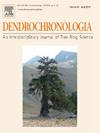Impact of compound drought--heat stress on Mongolian Scots pine growth: A Copula-based analysis across precipitation gradients
IF 2.7
3区 农林科学
Q1 FORESTRY
引用次数: 0
Abstract
Background
Compound drought–heat events increasingly threaten forests, yet responses, especially across moisture gradients, remain poorly understood compared to single extremes. We assessed Mongolian Scots pine (Pinus sylvestris var. mongolica) radial growth responses to high-intensity compound drought–heat events (HICEs) across a precipitation gradient (low/MG, medium/TH, high/XL sites) in China’s northern Greater Khingan Mountains, focusing on precipitation’s modulating role.
Methods
Using dendrochronology (Standardized Ring-Width Index, RWI; 1958–2023 CE) and climate data (Palmer Drought Severity Index, PDSI; Vapor Pressure Deficit, VPD), we employed Copula functions to model the joint probability of May-July low PDSI and high VPD, generating a Compound Drought–Heat Severity Index (CDHSI). We identified HICEs (CDHSI <−1.6) and quantified differential growth responses using resilience metrics (resistance Rt, recovery Rc, resilience Rs).
Results
Mongolian Scots pine radial growth was primarily constrained by moisture stress, exhibiting significant negative correlations with May-July VPD (e.g., MG: r=−0.57; TH: r=−0.18) and a positive correlation with PDSI in the low-precipitation zone (MG: r=0.43). The Copula-derived CDHSI effectively captured compound stress (correlating with VPD r=−0.78, PDSI r=0.80) and identified nine HICEs, frequently coinciding with negative pointer years. HICEs significantly suppressed growth, most severely (p<0.01) under low precipitation (MG), with significant multi-year growth differences (p<0.05) compared to high precipitation (XL). Recovery strategies diverged: low-precipitation pines showed decreased resistance (Rt: 0.6→0.42) but increased recovery (Rc: 1.4→1.98) with event severity, while high-precipitation pines showed enhanced Rt, Rc, and Rs.
Conclusions
This first Copula-based regional assessment demonstrated significant HICE-induced growth inhibition in Mongolian Scots pine, strongly modulated by precipitation. Sites with low precipitation exhibited heightened sensitivity to HICEs, whereas high precipitation enhanced both resistance and recovery. These quantified findings address critical knowledge gaps regarding forest responses to compound stressors and provide a crucial foundation for developing adaptive forest management strategies under projected climate change.
旱热复合胁迫对蒙古苏格兰松生长的影响:基于copula的降水梯度分析
复合干热事件对森林的威胁越来越大,但与单一极端事件相比,人们对其响应,特别是对不同湿度梯度的响应仍然知之甚少。研究了中国大兴安岭北部不同降水梯度(低/MG、中/TH、高/XL)下蒙古苏格兰松(Pinus sylvestris var. mongolica)径向生长对高强度复合干热事件(HICEs)的响应,重点研究了降水的调节作用。方法采用树木年代学(标准化环宽指数,RWI;(1958-2023 CE)和气候数据(Palmer Drought Severity Index, PDSI;利用Copula函数对5 - 7月低水汽压差(VPD)和高水汽压差(VPD)的联合概率进行建模,得到复合干热严重指数(CDHSI)。我们确定了HICEs (CDHSI <−1.6),并使用弹性指标(抗性Rt,恢复Rc,弹性Rs)量化了差异生长响应。结果油松径向生长主要受水分胁迫的制约,与5 - 7月VPD呈显著负相关(MG: r= - 0.57;TH: r= - 0.18),与低降水区PDSI呈正相关(MG: r=0.43)。copula衍生的CDHSI有效地捕获了复合应力(与VPD相关r= - 0.78, PDSI r=0.80),并识别出9个HICEs,这些HICEs通常与负指针年份相吻合。与高降水(XL)相比,高降水显著抑制了植物生长,在低降水(MG)条件下最严重(p<0.01),且多年间差异显著(p<0.05)。随着事件严重程度的增加,低降水量松树的抗性降低(Rt: 0.6→0.42),但恢复增加(Rc: 1.4→1.98),而高降水量松树的Rt、Rc和rs增强。结论首次基于copula的区域评估表明,hece诱导的蒙古苏格兰松生长抑制显著,受降水的强烈调节。低降水量地区对HICEs的敏感性较高,而高降水量地区对HICEs的抗性和恢复能力均有增强。这些量化的研究结果填补了森林对复合压力响应的关键知识空白,并为在预计的气候变化下制定适应性森林管理战略提供了重要基础。
本文章由计算机程序翻译,如有差异,请以英文原文为准。
求助全文
约1分钟内获得全文
求助全文
来源期刊

Dendrochronologia
FORESTRY-GEOGRAPHY, PHYSICAL
CiteScore
5.50
自引率
13.30%
发文量
82
审稿时长
22.8 weeks
期刊介绍:
Dendrochronologia is a peer-reviewed international scholarly journal that presents high-quality research related to growth rings of woody plants, i.e., trees and shrubs, and the application of tree-ring studies.
The areas covered by the journal include, but are not limited to:
Archaeology
Botany
Climatology
Ecology
Forestry
Geology
Hydrology
Original research articles, reviews, communications, technical notes and personal notes are considered for publication.
 求助内容:
求助内容: 应助结果提醒方式:
应助结果提醒方式:


